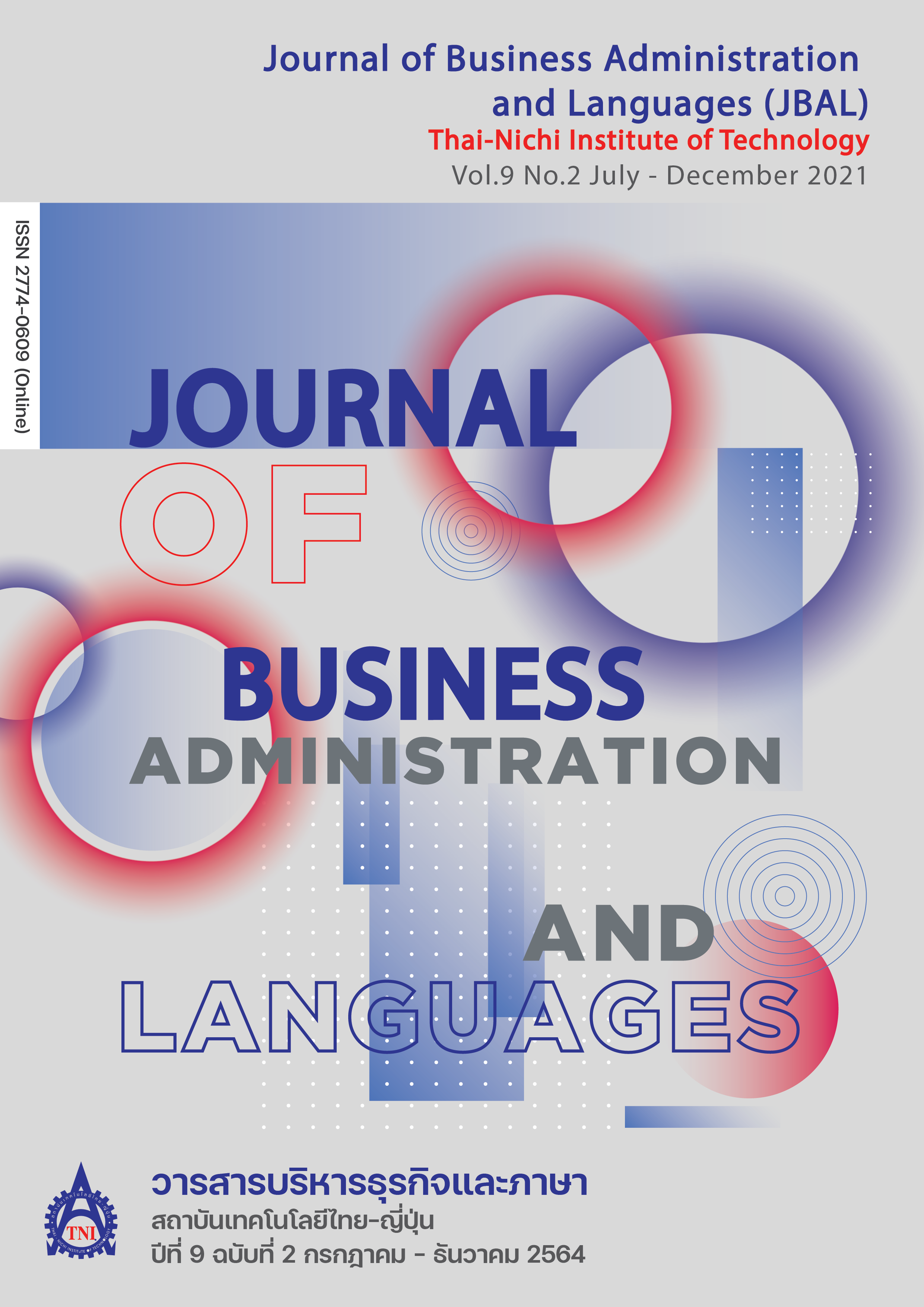การปรับปรุงวิธีการทำงานเพื่อลดความสูญเปล่าของกระบวนการจัดเก็บวัตถุดิบในคลังสินค้า ด้วยเทคนิค Operation Analysis (กรณีศึกษาโรงงานอุตสาหกรรมชิ้นส่วนยานยนต์)
Main Article Content
บทคัดย่อ
งานวิจัยนี้มีวัตถุประสงค์เพื่อลดความสูญเปล่า (7 Waste) ที่เกิดขึ้นจากการขนย้าย (Transportation) และขั้นตอนการทำงานที่มากเกินไป (Over Process) ของกระบวนการจัดเก็บวัตถุดิบในคลังสินค้า ด้วยการสร้างมาตรฐานในการทำงาน โดยตั้งแต่การจับเวลา และจดบันทึกข้อมูลการทำงานของพนักงานด้วยแบบฟอร์ม Operation Analysis Chart จากนั้นนำข้อมูลที่ได้มาสร้างเป็นฐานข้อมูล (Data Base) โดยวิเคราะห์องค์ประกอบของงาน (Work Element) ด้วยเครื่องมือ Yamazumi Chart เพื่อที่จะค้นหาความสูญเปล่าที่เกิดขึ้นในกระบวนการทำงาน จากการเก็บรวบรวมข้อมูล และศึกษาสภาพปัจจุบันพบว่าระยะทางที่ไกลที่สุดในการเดินจัดเก็บวัตถุดิบต่อหนึ่งพาเลทเท่ากับ 322 เมตร/พาเลท ใช้เวลา 11.5 นาที หลังจากการปรับปรุงการทำงานด้วย ECRS เพื่อขจัดความสูญเปล่าที่เกิดขึ้นในกระบวนการทำงาน และสร้างมาตรฐานการทำงานขึ้นมาทำให้ ระยะทางที่ไกลที่สุดในการเดินจัดเก็บวัตถุดิบต่อหนึ่งพาเลทลดลงเหลือ 110 เมตร/พาเลท ใช้เวลา 6 นาที/พาเลท ส่งผลให้ใช้เวลาในการจัดเก็บวัตถุดิบลดลง ร้อยละ 65.83 มีระยะทางในการเดินจัดเก็บสินค้าลดลง ร้อยละ 47.82
Article Details
นโยบายการรับบทความ
กองบรรณาธิการวารสารสถาบันเทคโนโลยีไทย-ญี่ปุ่น มีความยินดีรับบทความจากอาจารย์ นักศึกษา และผู้ทรงคุณวุฒิในสาขาบริหารธุรกิจและภาษา ที่เขียนเป็นภาษาไทยหรือภาษาอังกฤษ ซึ่งผลงานวิชาการที่ส่งมาขอตีพิมพ์ต้องไม่เคยเผยแพร่ในสิ่งพิมพ์อื่นใดมาก่อน และต้องไม่อยู่ในระหว่างการพิจารณาของวารสารอื่นที่นำส่ง ดังนั้นผู้สนใจที่จะร่วมเผยแพร่ผลงานและความรู้ที่ศึกษามาสามารถนำส่งบทความได้ที่กองบรรณาธิการเพื่อเสนอต่อคณะกรรมการกลั่นกรองบทความพิจารณาจัดพิมพ์ในวารสารต่อไป ทั้งนี้บทความที่สามารถเผยแพร่ได้ประกอบด้วยบทความวิจัย ผู้สนใจสามารถศึกษาและจัดเตรียมบทความจากคำแนะนำสำหรับผู้เขียนบทความ
การละเมิดลิขสิทธิ์ถือเป็นความรับผิดชอบของผู้ส่งบทความโดยตรง บทความที่ได้รับการตีพิมพ์ต้องผ่านการพิจารณากลั่นกรองคุณภาพจากผู้ทรงคุณวุฒิและได้รับความเห็นชอบจาก กองบรรณาธิการ
ข้อความที่ปรากฏภายในบทความของแต่ละบทความที่ตีพิมพ์ในวารสารวิชาการเล่มนี้ เป็น ความคิดเห็นส่วนตัวของผู้เขียนแต่ละท่าน ไม่เกี่ยวข้องกับสถาบันเทคโนโลยีไทย-ญี่ปุ่น และคณาจารย์ท่านอื่น ๆ ในสถาบัน แต่อย่างใด ความรับผิดชอบด้านเนื้อหาและการตรวจร่างบทความแต่ละบทความเป็นของผู้เขียนแต่ละท่าน หากมีความผิดพลาดใด ๆ ผู้เขียนแต่ละท่านจะต้องรับผิดชอบบทความของตนเองแต่ผู้เดียว
กองบรรณาธิการขอสงวนสิทธิ์มิให้นำเนื้อหา ทัศนะ หรือข้อคิดเห็นใด ๆ ของบทความในวารสารวิชาการ สถาบันเทคโนโลยีไทย-ญี่ปุ่น ไปเผยแพร่ก่อนได้รับอนุญาตจากผู้นิพนธ์อย่างเป็นลายลักษณ์อักษร ผลงานที่ได้รับการตีพิมพ์ถือเป็นลิขสิทธิ์ของวารสารสถาบันเทคโนโลยีไทย-ญี่ปุ่น
หากต้องการสอบถามข้อมูลเพิ่มเติมที่
- กองบรรณาธิการ วารสารสถาบันเทคโนโลยีไทย-ญี่ปุ่น
- ฝ่ายวิจัยและนวัตกรรม สถาบันเทคโนโลยีไทย-ญี่ปุ่น
เลขที่ 1771/1 สถาบันเทคโนโลยีไทย-ญี่ปุ่น ซอยพัฒนาการ 37-39 ถนนพัฒนาการ แขวงสวนหลวง เขตสวนหลวง กรุงเทพมหานคร 10250 ติดต่อกับคุณพิมพ์รต พิพัฒนกุล (02) 763-2752 , คุณอาริสา จิระเวชถาวร (02) 763-2600 Ext. 2704 Fax. (02) 763-2754 หรือ E-mail: JBAL@tni.ac.th
เอกสารอ้างอิง
Amornrat Pinchaioon, Natthaphol Siriruk, & Sirapong Lueachai. (2018). Improvement Production Line of Auto Part using industrial Engineering Tools. (in Thai). The Journal of Industrial Technology, 14(3), 93–105.
Kusuma Chaiyachot. (2016). Time Reduction for Product Fulfillment on Shelves Using Kanban System: A Case Study of Retail Business. An independent study submit (Master’s thesis). Retrieved from http://dspace.spu.ac.th/handle/123456789/5594
Nuttawut Pumpruek, & Varin Vongmanee. (2020). Process Improvement and Increasing Efficiency by Using Lean Management Case study of GPS Tracking&IoT Solutions Company. Proceedings of the 15th RSU National Graduate Research Conference, 15(2563) 1181–1193. Retrieved from https://rsujournals.rsu.ac.th/index.php/rgrc/article/view/1928
Somphan Wannarot. (2018). The Increasing of Performance Efficiency by Using Kaizen Concept: Case Syudy of Y S Pund Co., Ltd. (Master’s thesis). Retrieved from http://thesis.rru.ac.th/files/pdf/696_2019_03_21_112129.pdf
Toyota Seisan Houshiki wo Kangaeru Kai. (2010). TOYOTA Production System (5th ed.). (Mangkorn Rodprapakorn, Trans.). Bangkok, Thailand: TPA Publishing.
Thanarak Heebgaew. (2017). Process Improvement of Pressing Process by Using 7 Wastes. Proceeding of IE Network Conference 2017. Retrieved from http://research-system.siam.edu/images/IE/Thanarak/60_1/1.pdf
Thanchuda Phannikul, Duangporn Sangkamanee, & Preedaporn Ngamsanga. (2014). Efficiency Improvement in Manufacturing Process by Industrial Engineering Tools Case Study: Bicycle Assembly Factory. Proceeding of IE Network Conference 2014, 227–234. Retrieved from http://app.eng.ubu.ac.th/~ie/article/pdf/2557/ie_network_2014_01.pdf
Uraiwan Wansiri. (2019). Applying of Lean Concepts to Increase the Efficiency of Storage Space: A Case Study of Door and Window Equipment Dealers. (in Thai). NKRAFA Journal of Science and Technology, 15, 67–78.
Vithinut Phakphonhamin. (2019). Research Kaizen of Standardized Work Analysis with Motion Study by Time Prism Software (Case study: Textile Industry). (in Thai). TNI Journal of Engineering and Technology, 7(1), 65–72.
Yuthanarong Jongjun, Kittipong Sangbuddee, Yodnapha Ketmuang, & Nara Buripun. (2014). Productivity Improvement of Hard Disk Drive Component Plating Process. (in Thai). Journal of Humanities and Social Sciences Thonburi University, 8(16), 25–38.


